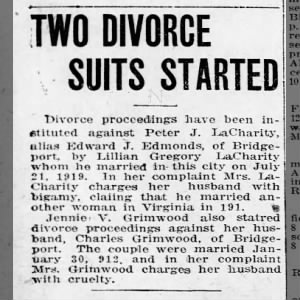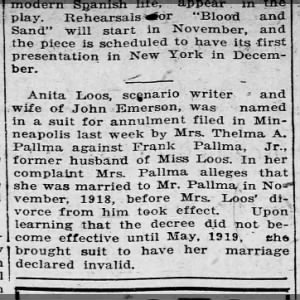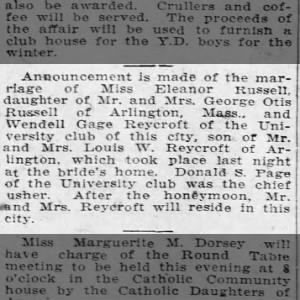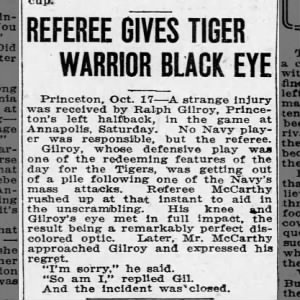
The Bridgeport Times and Evening Farmer Archive
- Bridgeport, Connecticut
- 1909–1922
About
The daily Bridgeport Evening Farmer, the Bridgeport Times and Evening Farmer, and the weekly Republican Farmer trace their roots to the publishing world of 18th-century Connecticut. This family of newspapers began in March 1790 in Danbury as the Farmers Journal and went through a number of name changes during the last decade of the century, becoming the Farmers Chronicle in 1793 and the Republican Journal in 1796. From 1800 through January of 1803, and then again after September 1803, it was called the Farmers Journal. For a few months from February to May or June 1803, under the leadership of a dynamic and determined editor named Stiles Nicholas, it was called the Farmer’s Journal and Columbian Ark.
The daily Bridgeport Evening Farmer, the Bridgeport Times and Evening Farmer, and the weekly Republican Farmer trace their roots to the publishing world of 18th-century Connecticut. This family of newspapers began in March 1790 in Danbury as the Farmers Journal and went through a number of name changes during the last decade of the century, becoming the Farmers Chronicle in 1793 and the Republican Journal in 1796. From 1800 through January of 1803, and then again after September 1803, it was called the Farmers Journal. For a few months from February to May or June 1803, under the leadership of a dynamic and determined editor named Stiles Nicholas, it was called the Farmer’s Journal and Columbian Ark.
Although Connecticut was a Federalist stronghold, the Journal-Ark, whose slogan was “Be just and fear not,” maintained staunchly Democratic political sentiments. In 1807, Nicholas was fined and jailed while defending the Democratic editor of another publication against libel. Nicholas still managed to write and print a pamphlet from jail, thus ensuring that the publication of the newspaper was not interrupted. In 1810, Nicholas moved his paper, now called the Republican Farmer, to the growing town of Bridgeport. Initially, the Farmer’s four pages were filled mostly with advertisements and national and international items drawn from other newspapers, usually about a month behind in date. In later years, the paper expanded to eight pages, and modern technologies such as the telegraph, telephone, and ocean cables improved the immediacy and availability of the news.
In 1837, Stiles Nicholas’s son, Roswell, took over editorship and in 1840 complete management of the Republican Farmer. Reports say that his successor, William S. Pomeroy, began the Daily Farmer in 1854, but the earliest daily that still exists is the Daily Advertiser and Farmer, a title that began on September 8, 1856. Pomeroy partnered with a Yale-educated southerner named Nathan Stephen Morse who was highly critical of Lincoln, expressed anti-abolitionist views, and proposed peace with the South in his editorials both prior to and during the Civil War. On August 24, 1861, a pro-union mob led by soldiers attacked the Farmer’s offices, smashing and throwing presses into the streets and ransacking and burning files and materials. By some accounts, Morse escaped by climbing over the rooftops of adjacent buildings and then by hiding in a canal boat. He returned to the South, and Pomeroy was eventually able to resume publication of the paper.
After the Civil War, journalist James B. Gould and printer Henry B. Stiles took over the publication of the two papers, the long-lived weekly Republican Farmer and the daily, then called the Evening Farmer and later, the Bridgeport Evening Famer. Stiles son-in-law, Floyd Tucker, eventually took over editorial responsibilities. Tucker maintained the newspaper’soutspoken Democratic tradition and engaged in bitter disputes with other publications while vigorously supporting particular candidates for office. Bridgeport Mayor Denis Mulvihill credited the Farmer with securing his re-election in 1903. During the Tucker era, the Bridgeport Evening Farmer continued to champion the cause of labor by advocating for better wages and shorter work hours. During the nationally significant strikes for the eight-hour work day in Bridgeport in1915, the Farmer supported the organization of women workers. During World War I, however, it urged the city’s militant machinists’ union to submit to government restrictions on work stoppages.
Between 1917 and 1927, the newspaper underwent numerous titles changes. The Bridgeport Evening Farmer was renamed the Bridgeport Times and Evening Farmer in 1918, the Bridgeport Times in 1924, the Bridgeport Times, Bridgeport Evening Farmer in February 1925, and the Bridgeport Times, Evening Farmer in August 1925. TheTimes merged on November 1, 1926, with the weekly Bridgeport Star to form the Bridgeport Times, the Bridgeport Star. The title was simplified to the Times-Star in 1927.
The Tucker era was the last period in which the paper’s editorial policy was strictly partisan. In 1926, Sumner Simpson and Morton E. Judd formed a corporation with James L. McGovern, and newspaper executive Henry D. Bradley became General Manager. McGovern remained editor after the Times-Star merger in 1926, and many employees of theFarmer, theTimes, and the Star remained at the paper in some capacity. The Times-Star shed its allegiance, however, to its Jeffersonian, Democratic roots declaring itself an “independent newspaper” that would offer non-partisan reporting and adhere to “modern standards of journalism.” By November 1930, the Times-Star claimed a circulation of 22,000 and a readership of 100,000. At one time, it even outpaced the highly successful daily Bridgeport Post in circulation and advertising revenue. However, during the Depression years, the newspaper was unable to pay dividends to its shareholders, and so, after recalling its “continuous service to the community” for 151 years, theTimes-Star published its last issue on November 25, 1941.
Archive Info
- 57,704
- Bridgeport, Connecticut
- 1909–1922
Paper History
- The Bridgeport Evening Farmer
Source Information
The Bridgeport Times and Evening Farmer, 1918–1922 [database on-line]. Lehi, UT, USA: Ancestry.com Operations, Inc., 2024. Last updated: October 19, 2022
Recent Article Clippings
See All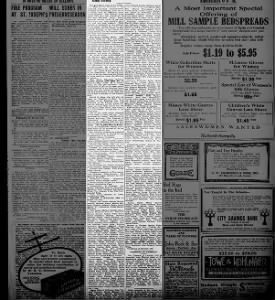
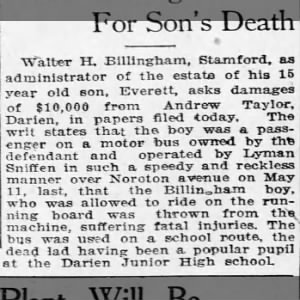
Everett Billingham fatal accident information.
The Bridgeport Times and Evening Farmer